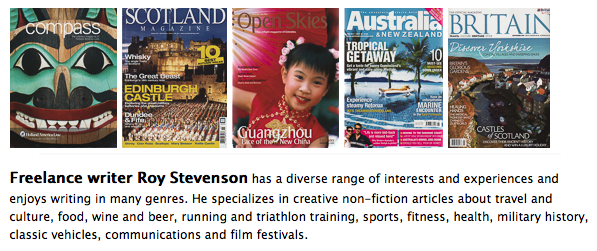- Home
- Building Your Writer's Website
- Bloggers and Print Media
7 Reasons
Bloggers Should Write
for Print Media
By Roy Stevenson
The Internet has completely changed the face of travel writing, and added another dimension to it. It has opened up many opportunities for travel writers.
With the digital age it became possible for anyone to become a travel writer. Many people started up travel websites and blogs, with thousands of them springing up, literally, overnight.
Before the Internet, travel information came from magazines, guidebooks, and books - all print media.
Now, a virtual encyclopedia of travel information can be found online. Guidebooks and magazines continue to sell, but many people today rely on the Internet for their travel information.
I browse the Internet constantly, looking for information, doing research or looking for quality websites about travel. And frequently I read beautifully written travel articles on blogs - stories easily worthy of publication in glossy print travel magazines. And I scratch my head and wonder, “Why didn’t the writer pitch this story to some magazines and get paid for it?”
Obviously, there are some travel bloggers out there who have the right stuff for getting published in print magazines.
I feel bad that their work is lost among the mass of information on the Internet - to be read by only a few people.
With this in mind, here are seven reasons bloggers should write for print media:
1. You will hone your writing skills
There’s a good reason why print is highly respected. To get your story into print it must go through a screening process. The process goes like this:
- First, since you have to convince an editor that your article will be interesting enough to publish, you have to dream up a dynamic story idea.
- Then, you have to pitch a well-crafted query letter to the editor, outlining your proposed story.
- Finally, your story must be well written enough (and perhaps even rewritten more than once) for the editor to sign off on it. Then, it finally gets printed.
This is a stringent process!
Travel blogging, on the other hand, requires no screening process or peer review. Although you might be a blogger who is diligent about posting well-written content, not everyone is so diligent.
I’ve run across many blogs that appear to be random thoughts with no attention to editing or quality content. This results in some shockingly bad travel writing being foisted on unsuspecting readers. Maybe the bloggers don’t care - or maybe they just need some expert feedback.
While I was compiling my list of quality websites for my eBook, 125 Websites That Want to Publish Your Travel Stories, I found out just how many excellent websites are out there - and how many were shockingly bad. (The bad ones didn’t make the list.)
Writing for print helps you hone your writing skills by providing you with a built-in expert review process for feedback. Editors help you learn what’s an acceptable standard and what’s not. It helps you develop as a writer.
2. You will improve your marketing skills
These days, everyone needs good marketing skills.
Dreaming up a salable story idea and then pitching your story idea to an editor in a query letter are marketing tasks. Developing your marketing skills will help you get published in print, market yourself online and ultimately help you market your blog.
Knowing how to promote yourself, your ideas and your website are important skills. Not everyone is born with these skills but they can be developed with some practice.
Getting published in print media gives you a process for honing these skills. You get to practice and find out what works (and what doesn’t). It helps you learn what kinds of story ideas sell - and which ones don’t interest editors. You get better at writing query letters - the main sales tool for travel writers.
Writing for print exposes you to the practice of marketing your ideas and selling them to an editor. You have nothing to lose and everything to gain.
3. You will add to your credibility as a writer and expert in your niche
Beyond developing your marketing skills, you will also gain print bylines to add to your credibility as a writer. People who read your blog want to see that you are the expert in your niche.
Having print bylines helps cement your credibility as an expert. Those print bylines look mighty nice on the “About” page on your blog. They round you out as a writer and take you to a realm beyond just being “a blogger”.

4. You’ll get paid for your writing, sometimes very well!
Unless you have monetized your blog, you’re not getting paid for all the hard work you put into it. Even if you’re contributing to someone else’s blog or travel website, chances are you’re not getting paid for your efforts.
The original idea behind blogging had nothing to do with making a profit, so it’s not surprising that many people blog for other reasons. A few of our readers have told us why they blog:
 |
 |
Patti Morrow (LuggageAndLipstick.com) likes to blog because it lets her be “more personal” in her writing. It also helps her make connections with people through her posts.
Kathleen Poole (AdventuringWomen.com) enjoys sharing her stories, opinions and exercising her writing muscles.
 |
 |
Shelley Pittman (A-Toast-To-Life.com) writes because sharing a story feeds her soul and “gives readers inspiration to try new things”.
And Angela Corrias (ChasingTheUnexpected.com) loves readers’ feedback, especially when they tell her she’s inspired them to get out of their comfort zone and engage with different cultures.
Blogs fulfill important human needs for expression, connection, inspiration and community. But no matter what your reasons are for blogging, chances are it doesn’t put much money in your pocket.
So why not use a different way to get paid for some of your hard work? Print media sits at the other end of the spectrum. Most print media pay you for your work. And, depending upon the publication, some pay very generously.
Of course, it takes some effort on your part to pitch your story ideas to the outside world of print media - but once you learn how to do it you'll find it's not difficult. And you’ll get paid to do it.
5. Print articles can drive new traffic to your website or blog
There is fierce competition for readers online among the thousands of travel websites and blogs. It’s diluted the readership of each website and blog and you need to post a lot of quality content just to get peoples' attention.
And, with on-going changes to search algorithms, bloggers can no longer rely solely on Google to send traffic their way. They need to constantly drive traffic in other ways. Social media strategies help, but there’s no reason to stop there.
Writing an article for print can generate interest and help send traffic to your blog.
When people like what they read in print articles, they’ll follow the link in your byline to your blog, even though they have to type it into the search box the old-fashioned way. I follow lots of links when I read an article that I like. You probably do this, too.

When you write for print, you’ll get traffic you would have otherwise missed. If the magazine reader likes your article and you provide valuable information, the reader will check out your byline and find you online.
One of the most important ways to drive the most traffic to your blog from print media is to focus on a niche. For example, if you’re a golfer then find the print publications that golfers read and get published there. Your audience is ready-made. All you need to do is deliver a good travel story and people will want to hear more about what you have to say.
6. You can give yourself a break and enjoy the thing you love to do: WRITE
I’ve heard some people advise beginning travel writers to “start a blog to build your writing portfolio”. I think this is bad advice.
Blogs are hard work! There are easier ways to build your writing portfolio.
Anyone who has actually created a blog knows that they are hard work. It isn’t easy to create fresh, new content every week - or several times a week. It takes time - your time!
Almost all of the travel bloggers who answered our survey said that finding enough time to write fresh content was one of their biggest challenges.
Think about it - you must be disciplined enough to sit down every day and write something. The only motivation is you - there are no deadlines and there is no accountability if you don’t post something this week (or next). Often this work doesn’t get done.
With your blog you play many roles: writer, editor, publisher and probably photographer. You also need to know SEO (search engine optimization) to get the search engines to send traffic to your blog. And you need to know your way around social media.
Patti Morrow (LuggageAndLipstick.com) says her biggest challenge is “getting viewers because there are a lot of competitive travel blogs.” She uses social media (Facebook, Twitter and Google+) to draw visitors to her site.
Because there are so many travel blogs, she advises aspiring bloggers to, “come up with something that is fresh and stimulating, or it will be difficult to find someone to read it besides your grandmother and BFF.”
When you write for print media you can let the magazine editor worry about readership. You can relax because you don’t have to play editor, publisher, SEO expert and social media expert.
Writing an article for print media lets you spend your time simply writing a great travel story. You can enjoy the single role of “writer”.
7. You’re more likely to get press trips and comped travel
As a writer who is primarily published in print magazines, journals, in-flights, and on-boards, I know the power that these media have for getting me fabulous press trips and Fam Tours around the U.S. and the world.
And I genuinely want all travel writers to enjoy the same rewards.
Convention and Visitors Bureau (CVB) reps have told me there’s a hierarchy of benefits available to travel writers, depending upon their outlets. Print media is still considered king. And, print magazines with six figure circulations is the King of Kings.
Tourism agencies and Public Relations (PR) companies need to show a return on their investment if they host you on a press trip or Fam tour. They need to show the value of your published article, and most of the time print media outweigh blogs.
If you want those cool international press trips, print outlets are more likely to help you get comps than a blog. Because of this, every travel blogger can benefit by writing for print media as well as writing for their own website or blog.
For a few years it seemed like the tables were turning and bloggers held the key to getting comps. But, since 2015 I’ve noticed that the tourism agencies have tightened up. They realize that many travel websites and blogs are only read by a dozen people each day - and mostly those are friends and family.
They haven’t been getting enough advertising bang for sponsoring travel bloggers on press trips and Fam Tours. They’re becoming more selective about accepting online assignments as collateral for these jaunts.
Am I saying that travel website editors and bloggers can’t score nice press trips? No, not at all.
I know several travel website editors and bloggers who get great press trips. These bloggers have either built up their sites over time and get good traffic, or they’re very good at marketing themselves and their niche. Probably both.
 |
 |
For example, Jan Ross (WanderlustWonder.com) says, “We very rarely pay for travel and usually that is just a few meals here and there and some gas. About 90% of our travel is comped and this includes such things as a river cruise in France - airfare included!”
Sandra Foyt (GetawayMavens.com) says she’s had amazing experiences with comped travel including learning to play golf and facing off with a bull in the Pyrenees.

And, Tim Cotroneo (TravelDreamsMagazine.com) says, “In addition to the other publications and websites I write for, Travel Dreams has been a springboard for staying at beautiful hotels, playing awesome golf courses, participating in press trips, five-course meals, and meeting people from all over the world.”
Ideally, you should come up with both print and online assignments for press trips. It’s this combination that usually proves too tempting for the tourism agency media reps to resist. This combination gives them enough of a return to host you.
Recently I visited with the media rep for the Anchorage, Alaska CVB at a small PR event here in Seattle. I presented him with a combination of confirmed print and online assignments. On the spot, he committed to sponsoring me and my wife/photographer on a press trip to Anchorage. His CVB will cover all our expenses for the week, and it’s because I offered him both print and online articles.
Bloggers and Print Media - a few final words
The transition from blog to print isn’t too much of a stretch for anyone with reasonable writing ability and some marketing skills. Freelance writing does require learning a specific set of rules and protocols, but these can be learned.
If you yearn to see your bylines in print media, and I hope most travel bloggers do, it’s time to strategically focus some of your time on targeting print media in your niche.
This will take away some of the time you’re currently spending on your travel blog, but you will find the benefits outweigh the extra effort. All it takes is a plan and a little motivation to get started.

Special Report:
How to Land Press Trips and Fam Tours
I've written a guide about how to land press trips. It will tell you everything you want to know about how to get into the inner circle and get invited on regional, national and international press trips.

Roy Stevenson is a professional travel writer and the author of www.PitchTravelWrite.com. Over the past ten years, he’s had more than 1000 articles published in 200 magazines, trade and specialty journals, in-flights, on-boards, blogs and websites and has traveled on assignment around the U.S. and to dozens of international destinations.
IF YOU ENJOYED THIS POST, GET UPDATES. IT'S FREE.















